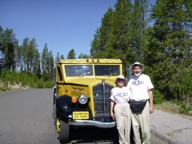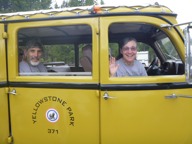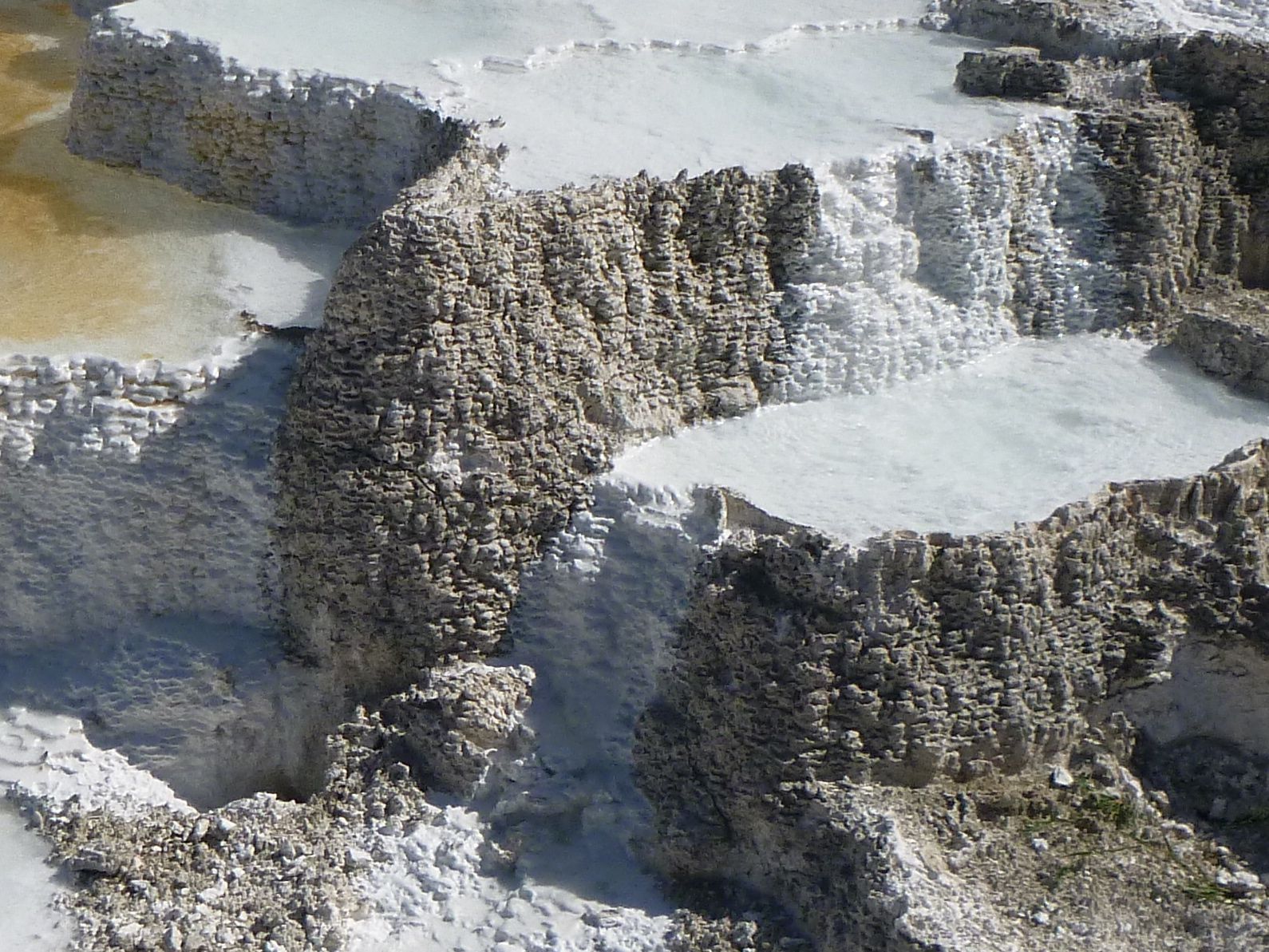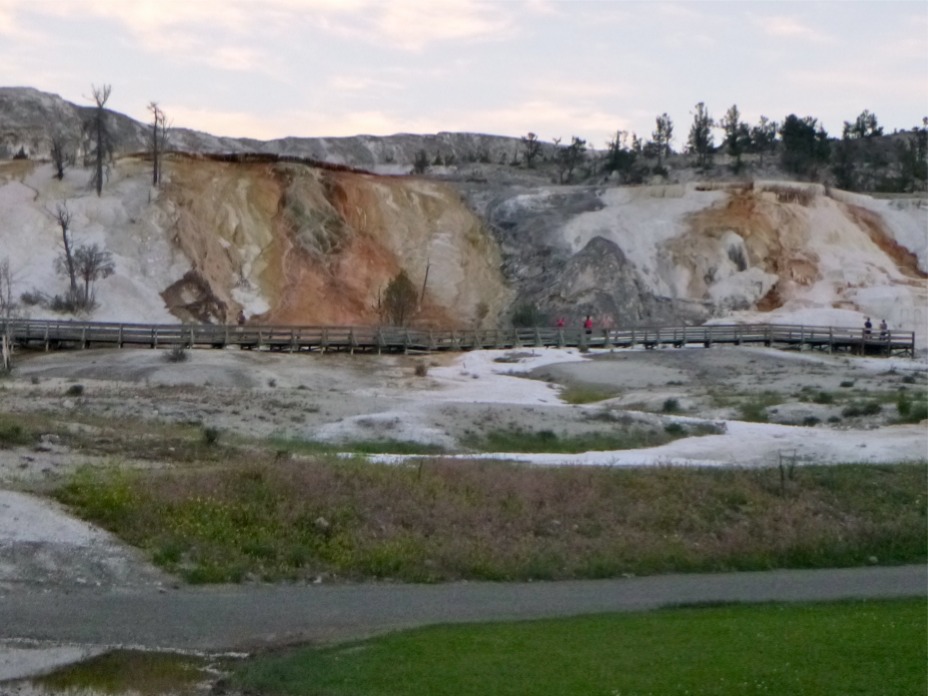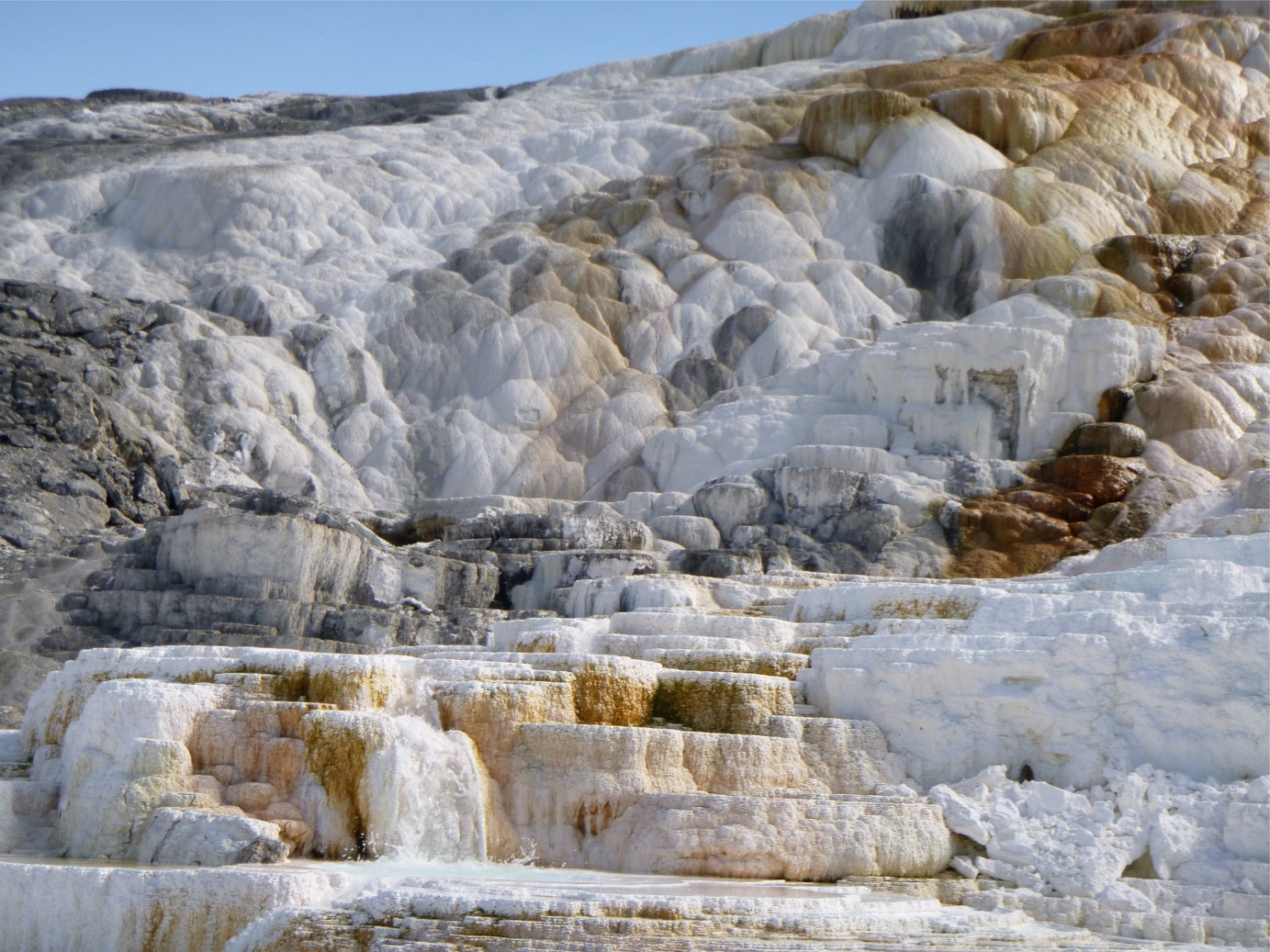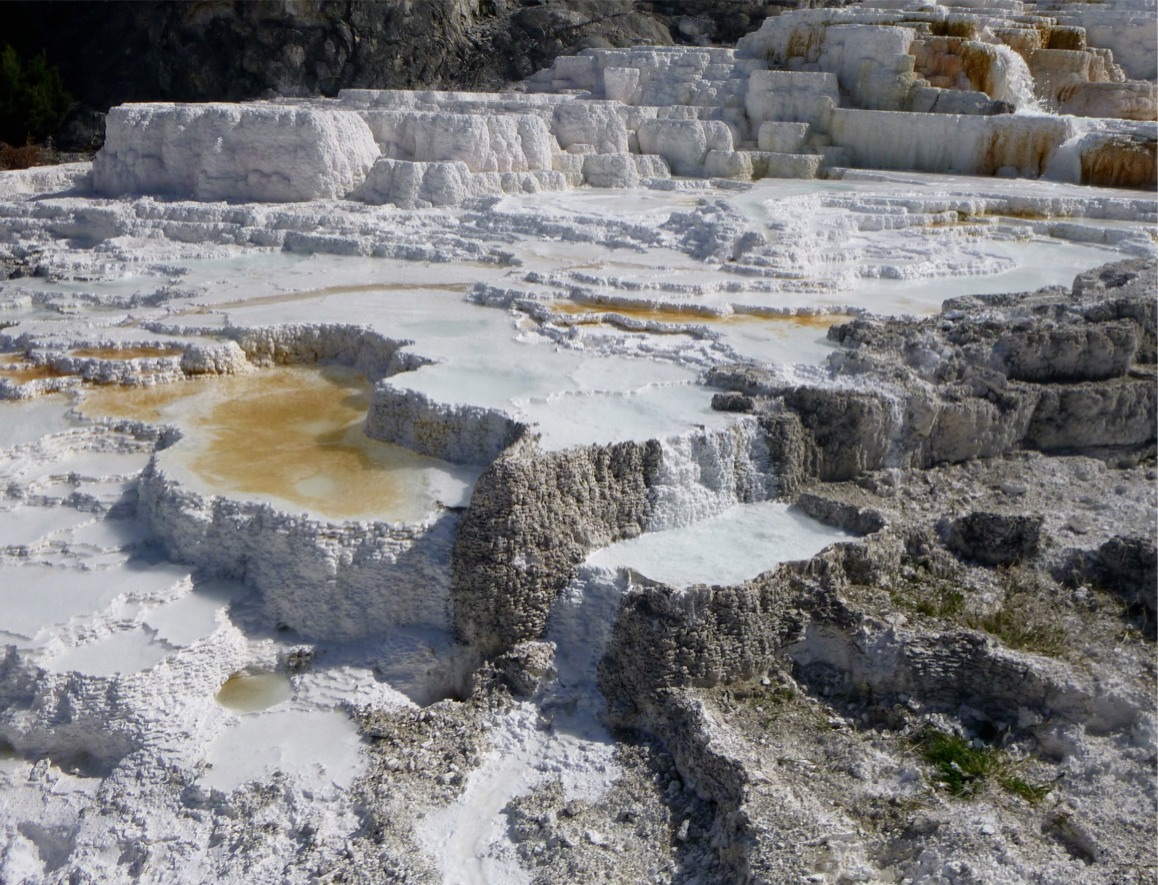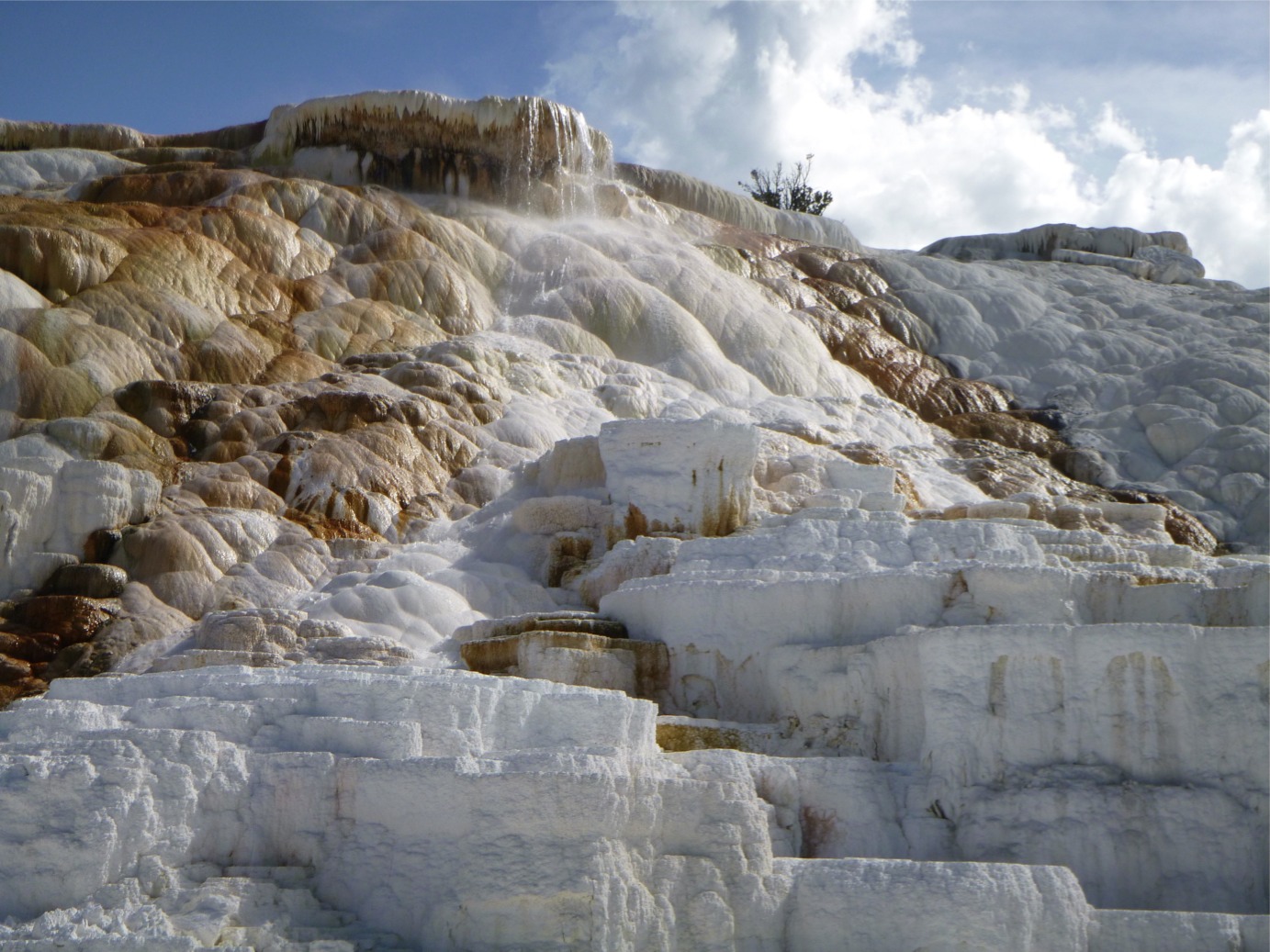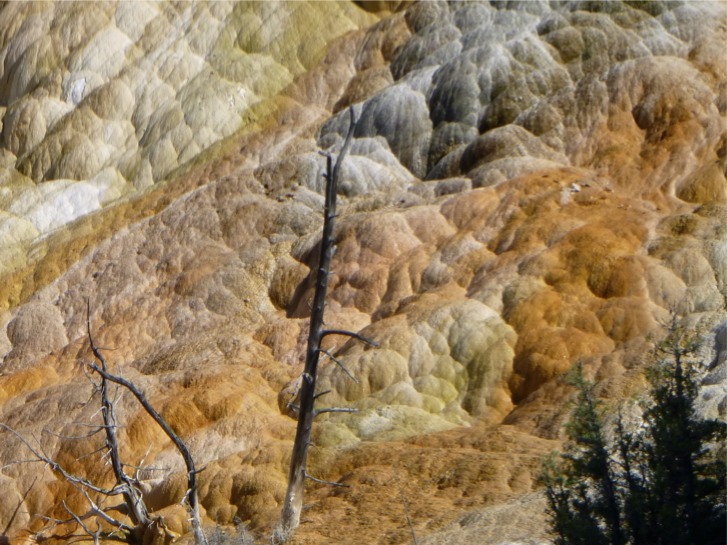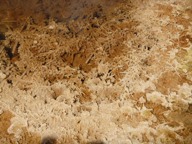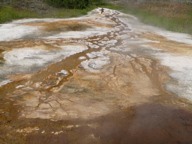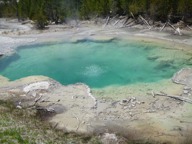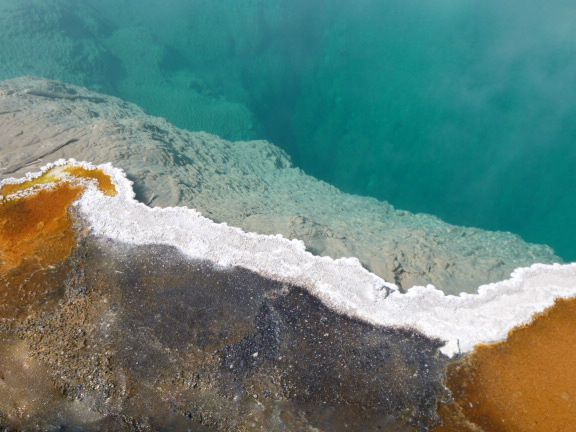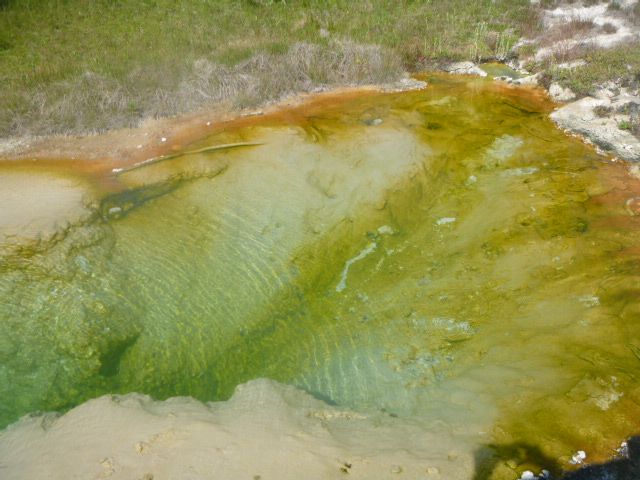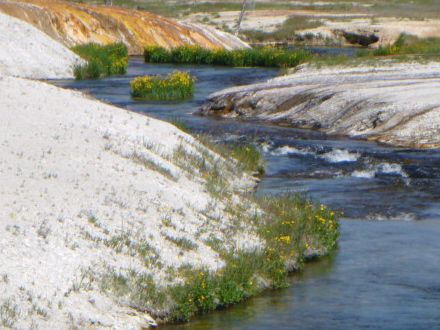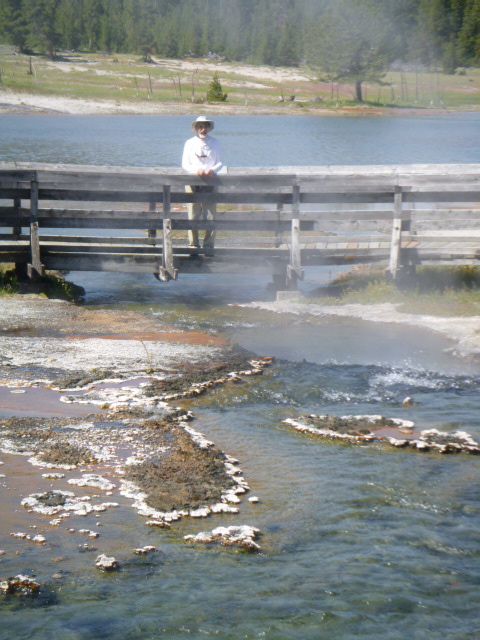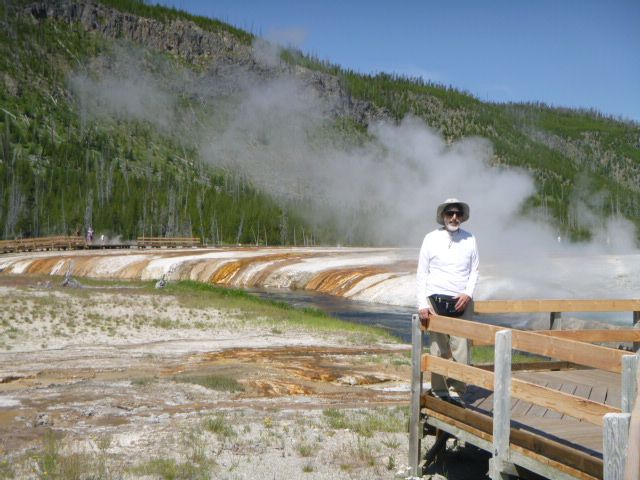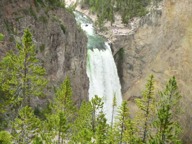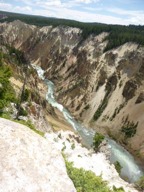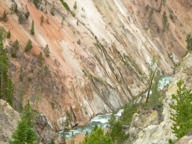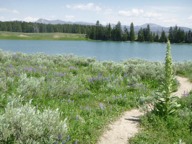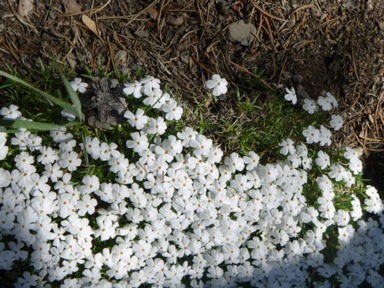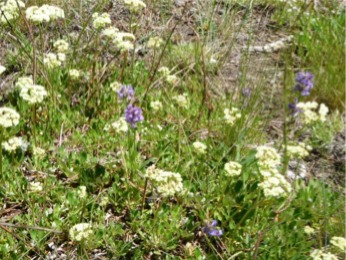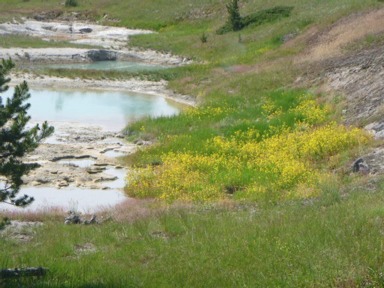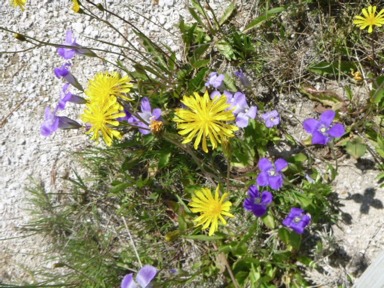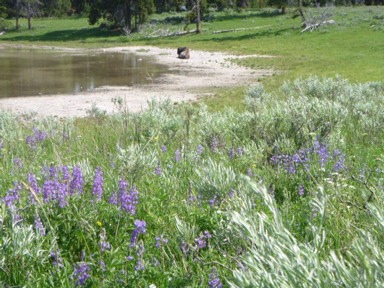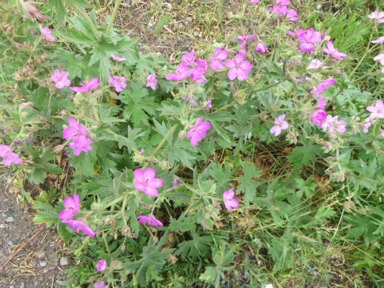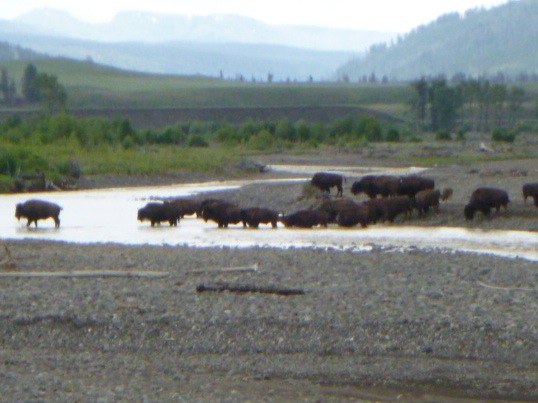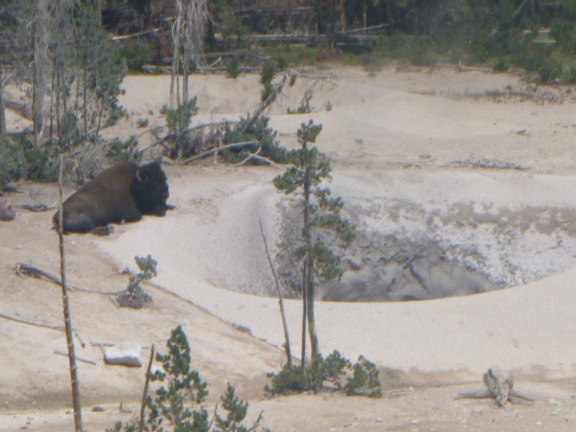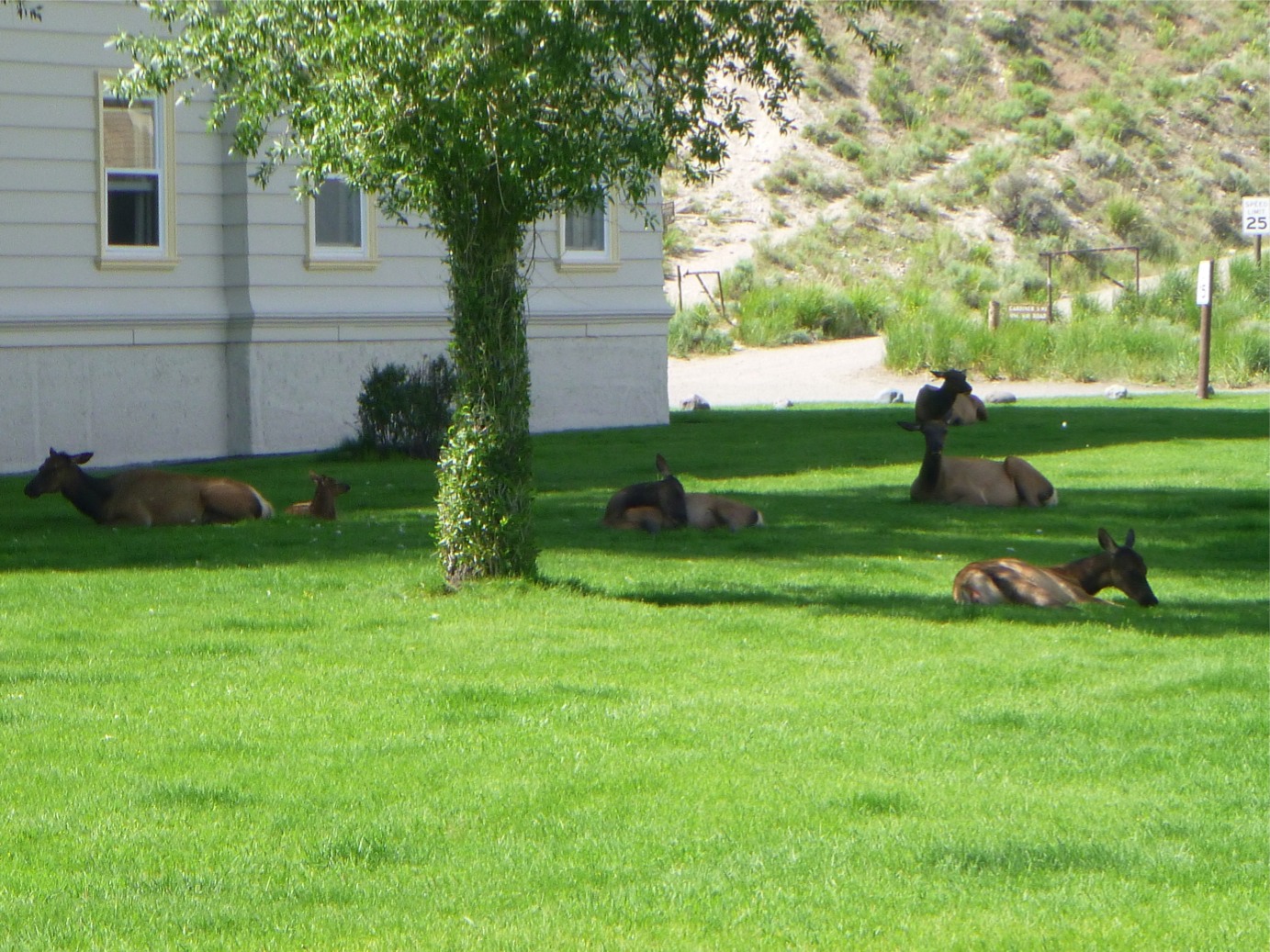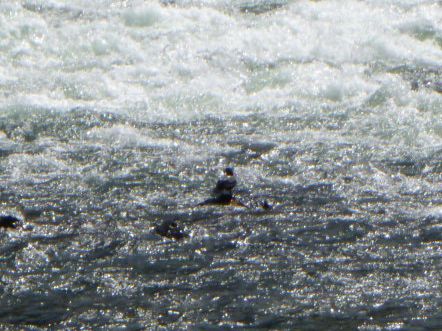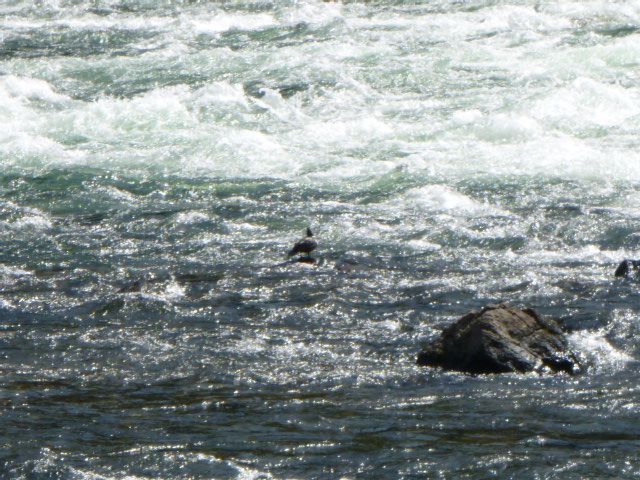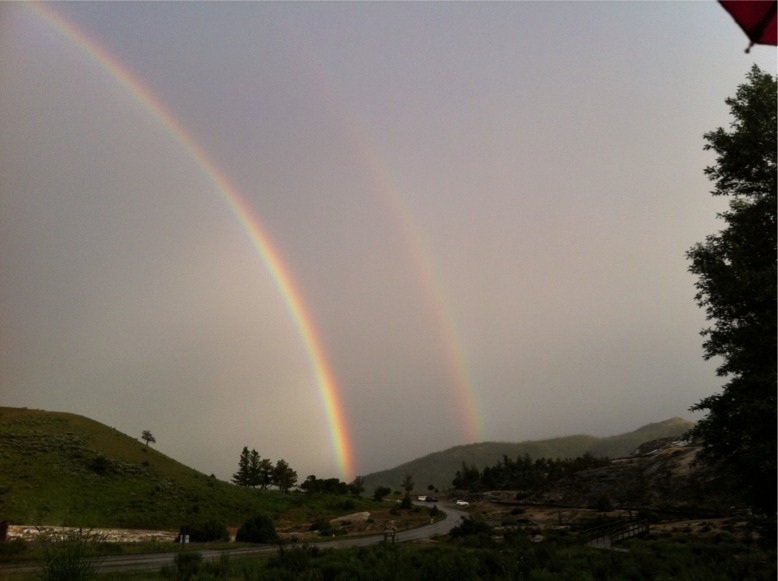Travels with Lois and Jason
Yellowstone National Park:
A Grand Tour
June 27 -- July 6, 2013
- Amazing colors
- Wild flowers
- Hot springs
- Fumaroles
- Mudpots
- Geysers
- Rock formations
- Thermophiles
- Bison, bear, moose, elk
- Birds
- Super volcano
The words above summarize our Yellowstone adventure. We traveled in a refurbished 1930s Yellow Touring Bus, capacity nine passengers, which gave us celebrity status as we cruised throughout the Park. We have never had our picture taken so many times -- it was great fun!!!
|
|
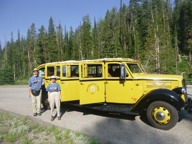 |
|
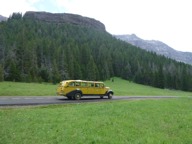 |
Our trip was like visiting four different ecosystems, each distinct in character, features, sights and sounds, but all four intimately tied to the underlying super-volcano upon which they sit. Our travels with a naturalist combined with our hours spent in the Education Centers, solidified much of our understanding of the powerful and awesome forces shaping this extremely diverse and incredible place. Our itinerary included two nights at each of the four major areas of the Park: Mammoth, Old Faithful, Canyon and Lake/Valleys. Before we visit each of these places, a couple of big Yellowstone ideas.
Some Yellowstone BIG Ideas
Yellowstone National Park is situated on a super-volcano. It is called super because the mouth of the volcano or caldera (the part that explodes) is an oval approximately 30 miles by 45 miles. For comparison, Mount Saint Helens' caldera is 1.2 miles by 1.8 miles. The Yellowstone volcano last exploded about 650,000 years ago, so everything inside the caldera is relatively young in terms of earth history. Following the last eruption, the caldera filled with lava, which cooled and created an environment ready for earthquakes and glaciers to carve and shape. But under all that lava is magma, which is the heat source for all those geysers, fumaroles, hot springs and mudpots.For Yellowstone National Park to be created required a significant change in the minds of the American people and legislators regarding the concept of "a wild place." Before the national park was created, the wilderness was viewed as a place full of danger: animals to be hunted, unknown territory, and mysterious phenomena. The Park's creation represented the complete opposite of these ideas: the wilderness is a place of beauty, of wonders to be valued, studied and understood, of animals to be viewed with pleasure, appreciated and protected. We agree with writer and historian Wallace Stegner who called our national parks "the best idea we ever had."
Mammoth Hot Springs
|
|
The travertine terraces
were like
looking at layers of lace: intricate yet simple,
complex yet elegant,
visually exciting. |
|
Here is an over-simplified explanation of how the terraces are formed: The terraces are created by boiling water seeping out of the ground carrying bits of dissolved calcium carbonate. The water cools in contact with the air and ground thus depositing the calcium carbonate, creating the terraces. Thermophiles (organisms that thrive at relatively high temperatures) give the terraces a range of colors: white when the temperature is closer to boiling, blues and greens a little cooler, and yellows, oranges and browns when the temperature is in the lower 100s range. The gray and black colors represent dead thermophiles. We saw these same color patterns throughout the Park.
|
|
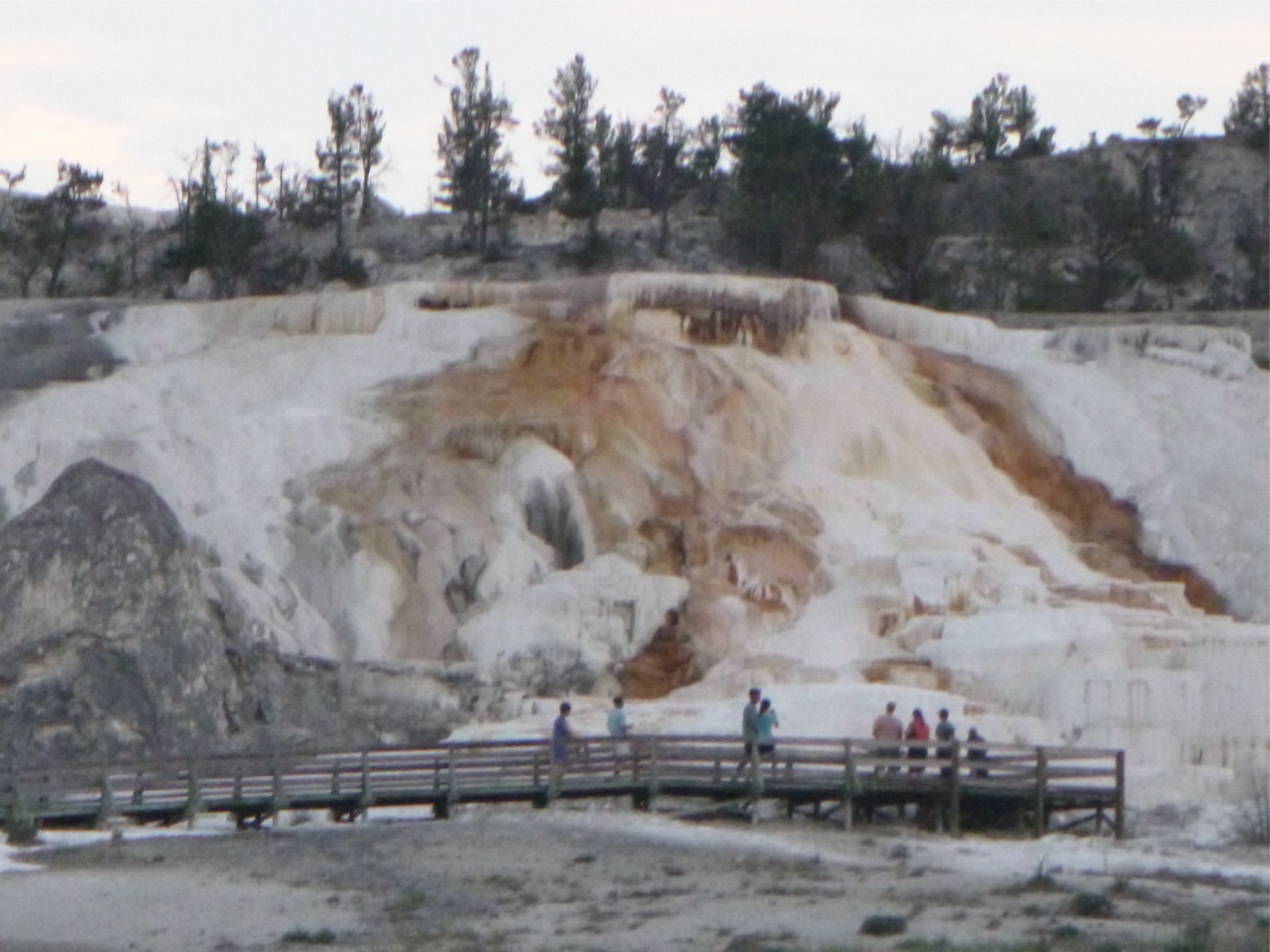 |
|
|
|
|
|
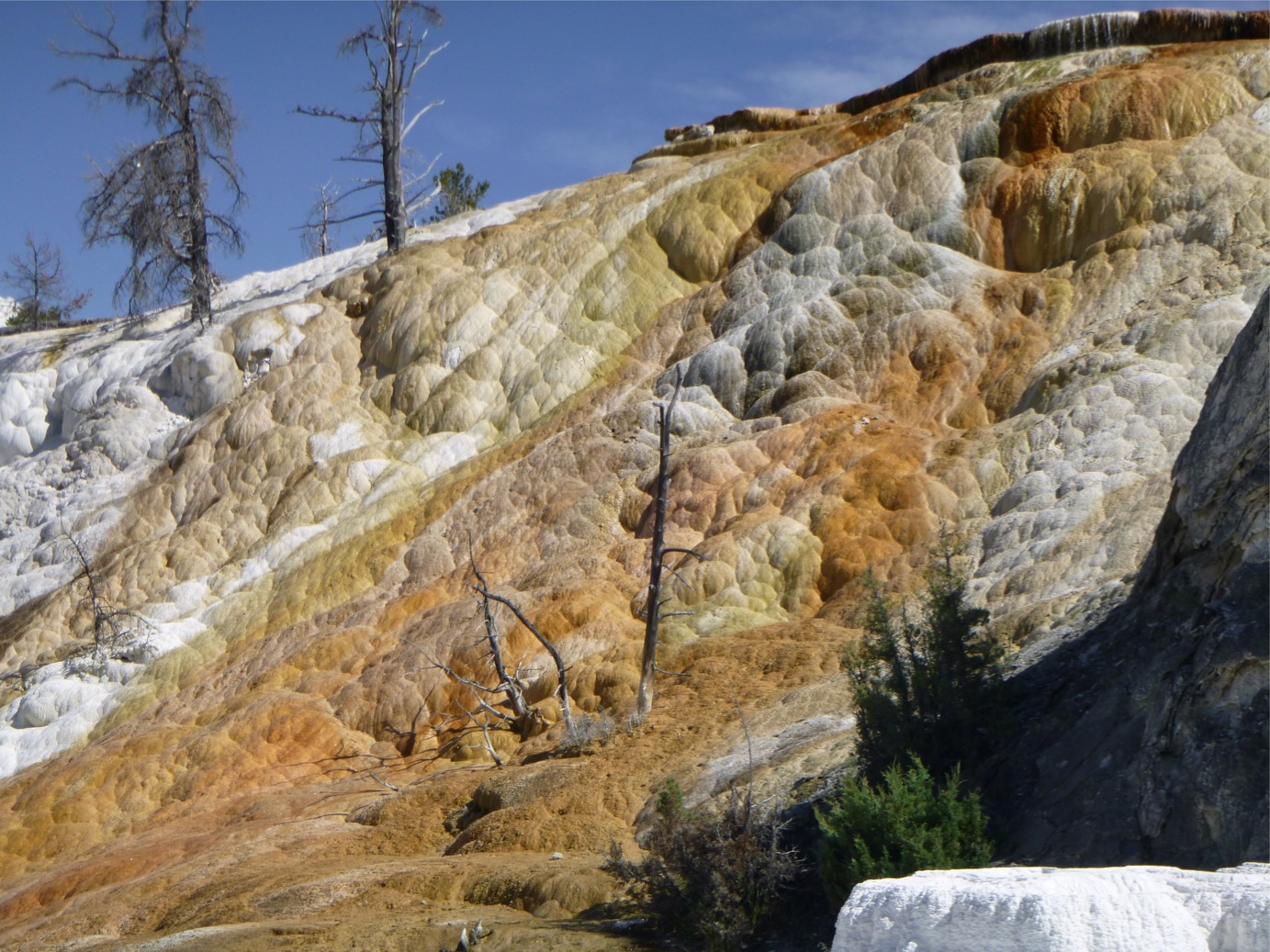 |
|
|
|
|
 |
|
Old Faithful and the Geyser Basins
About 60% of the geysers, fumaroles, hot springs and mudpots in the world are located in Yellowstone, and we saw a large number of them. We found the geysers fun to watch as they shot boiling water into the air creating huge clouds of steam, but the hot springs which are full of colorful thermophiles were most beautiful. Fumaroles (steam vents) with their hissing and mudpots that boil like soup with their gurgling bubbling gases were fascinating to watch, but the sulfur smelled like rotten eggs.For the four different geothermal features, water from rain and snow seeps deep into the ground and becomes superheated by the magma. As the hot water works its way back to the surface, one of four things (greatly simplified) happens:
| If the water comes out
without
any blockage, it is a hot spring. |
If the water collects in a
pool
and then bursts out all at once, it is a geyser. |
|
|
|
| Emeral
Spring Hot Spring |
Old
Faithful
Geyser |
| If the water comes out so
slowly
that it boils away faster than it can be replenished, it is a fumarole or steam vent. |
If there is very little water as it comes out, it is a mudpot. |
 |
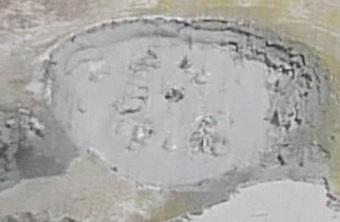 |
| a
fumerole |
Sulfur
Culdron Mudpot |
|
Geyers do not go off on a
set schedule,
although some like Old Faithful do go off regularly
enough that an
eruption interval has been determined. For Old
Faithful, for example, a 20
minute interval is given saying it should go off
between say 7:00 plus or minus 10 minutes, and it
ususally does.
For some geyers, the interval is 3 to 4 hours.
Some geyers are
totally unpredictable. We went to see Fountain
Geyer, which is
near Morning Geyer. Both went off
together. Our guide said
in his decades of coming to Yellowstone, this was the
first time he had
ever seen Morning Geyser errupt. I guess we were
extremely lucky
(and it's a great photo, too!) |
|
| Fountain
and
Morning Geyers |
|
|
 |
|
|
|
|
|
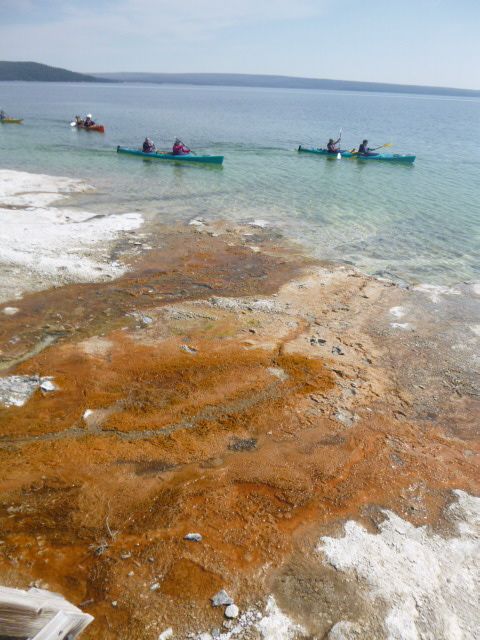 |
|
The Grand Canyon of Yellowstone
The Grand Canyon of Yellowstone is the most beautiful canyon we have seen in all our travels. The Yellowstone River careens its way through beige and light yellow canyon sides streaked with reds, browns, and golds. The lookout points give awesome views of the upper and lower falls and canyons from different perspectives.
|
|
 |
|
|
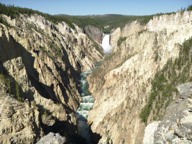 |
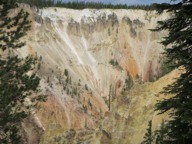 |
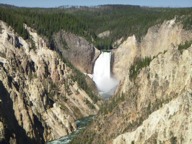 |
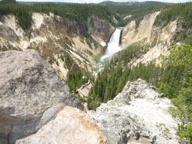 |
An interesting geological controversy surrounds The Grand Canyon of Yellowstone: when was it formed? Since the last volcanic eruption of the Yellowstone volcano was 650,000 years ago, the canyon has to be younger than that. The canyon has very steep V-shaped sides indicating that it was cut by the Yellowstone River and not carved by a glacier. Usually water cuts very slowly. For example, it took ten-million years to cut the Grand Canyon in Arizona. So, how could water cut such a fantastic canyon in Yellowstone in such a short period of time? It was fun to hear the different theories. Maybe someday scientist will sort it out.
Yellowstone Lake
Yellowstone Lake is the largest fresh water lake above 7000 feet
elevation in North America. When we first arrived and
studied the
map of the Park, we were very confused by the fact that two large
arms
of the lake extended outside the Yellowstone volcanic
caldera.
This puzzle
was solved as we learned that these arms were fresh water fjords,
that
is, two large canyons cut by glaciers which extended into a body
of
water and then flooded. The lake has hot springs feeding
into its
bottom and more hot springs and mudpots along it shore, but it
still
freezes each winter. 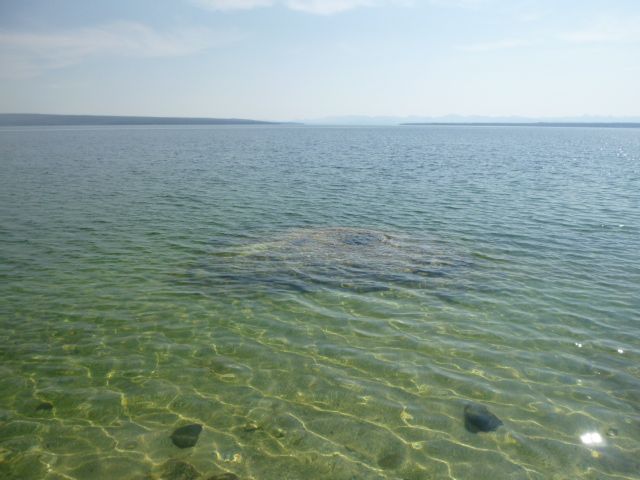 |
During the early 1900s people fished in the lake and then cooked their trout in this hot spring, as seen in picture to the right. Lois' picture of Fishing Cone Hot Spring shows the cone under water due to the spring snow melt. |
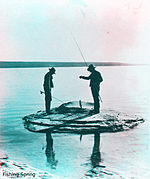 |
| Fishing
Cone
Hot Spring in Yellowstone Lake |
Picture
taken from internet |
|
|
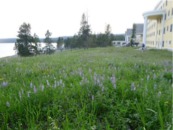 |
| Lake
hike
trail |
Lake
Hotel
with wildflower front yard! |
Unfortunately we were introduced to a major ecological disaster at the lake. Cut-throat trout are natural to the lake and are a major food source for bears and numerous birds. Tragically some years ago someone put the larger lake trout natural to the Great Lakes into Yellowstone Lake, as it is better for sport fishing. This larger invasive fish is killing off all the native cut-throat trout. Negative impacts on the bears and birds have already been observed, and the Park Services is spending millions each year to try and eradicate the lake trout.
Wild Flowers
We were surprised and delighted by the large variety and colorful nature of the wild flowers we saw throughout our trip. We saw fields and meadows covered in yellows, purples, pinks and whites. Along the roadside were individuals and clusters. Here are a few examples.|
|
 |
|
|
|
|
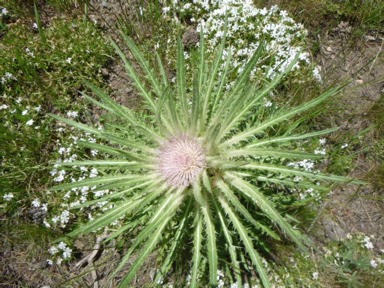 |
|
|
|
|
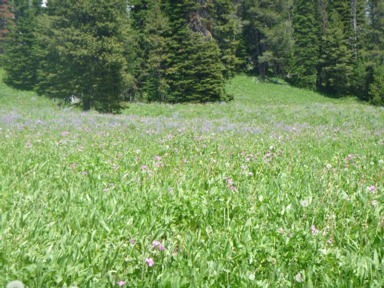 |
|
|
Bisons, Bears, Elks and a Moose
Bison (sometimes called buffalo) were everywhere -- along the
roads,
resting near hot springs, roaming in large herds through the
valleys
and across rivers. We took many pictures of the bison.
Bears were more elusive, but we saw three (two
grizzly and one black) off in the distance, unfortunately too far
for a
picture. The one and only moose that we saw was
hidden amongst the trees. Elk had taken over
the lawn at Mammoth Hotel.| Bison | 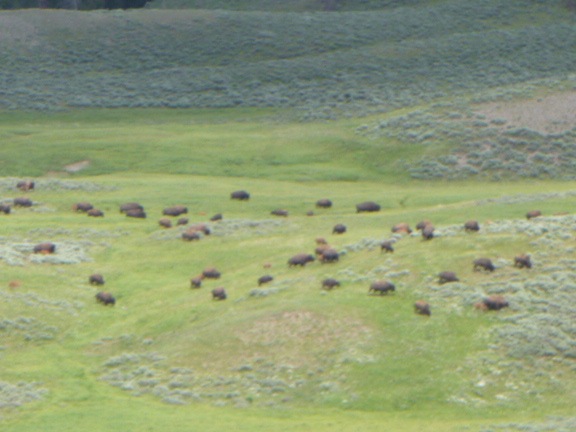 |
|
|
| Elk |
 |
|
We also visited the expansive U-shaped (meaning glacially carved) Lamar Valley, where we heard of the success of reintroducing wolves to Yellowstone (eradicated by man in the 1920s), saw massive herds of bison (now with a count above 4000 after being reduced to a couple of hundred in the 1870s by massive slaughter), and saw the non-native mountain goats (introduced by sport hunters at some point, but now seen as a benefit as they are helping the wolf population grow). (Regrettably we never saw a wolf.)
Birds
Using a powerful telescope, our guide showed us Osprey nesting high on a rock column in the middle of the Yellowstone River in the Grand Canyon, as well as a Golden Eagle in the distance. We could see White Pelicans, Canadian Snow Geese, and Ravens in abundance.|
|
But
the
prize view was the Harlequin Ducks, a bird which
specializes in
white water rafting, living in the rapids (class 2 to
4) of the
Yellowstone River. |
|
Rainbows
Our trip could not have ended with a more spectacular view: we had sunny hot weather all week and the last day was thunderstoms and hail. But, the DOUBLE rainbow on the last night was an incredible treat:|
|
|
|
Yes, a DOUBLE rainbow!
Lois and Jason Travel Logs
Frand Family Homepage
Photo journalist: Lois Frand
Writer: Jason Frand
Editor: Lois Frand
You can reach us via email at Jason or Lois July 10, 2013
